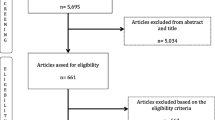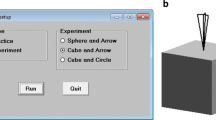Abstract
Background
This study addresses for the first time the relationship between working memory and performance measures in image-guided instrument navigation with Minimally Invasive Surgical Trainer-Virtual Reality (MIST-VR) and GI Mentor II (a simulator for gastroendoscopy). In light of recent research on simulator training, it is now prime time to ask why in a search for mechanisms rather than show repeatedly that conventional curriculum for simulation training has effect.
Methods
The participants in this study were 28 Swedish medical students taking their course in basic surgery. Visual and verbal working memory span scores were assessed by a validated computer program (RoboMemo) and correlated with visual–spatial ability (MRT-A test), total flow experience (flow scale), mental strain (Borg scale), and performance scores in manipulation and diathermy (MD) using Procedicus MIST-VR and GI Mentor 11 (exercises 1 and 3).
Results
Significant Pearson’s r correlations were obtained between visual working memory span scores for visual data link (a RoboMemo exercise) and movement economy (r = −0.417; p < 0.05), total time (r = −0.495; p < 0.01), and total score (r = −0.390; p < 0.05) using MIST-MD, as well as total time (r = −0.493; p < 0.05) and efficiency of screening (r = 0.469; p < 0.05) using GI Mentor 11 (exercise 1). Correlations also were found between visual working memory span scores in rotating data link (another RoboMemo exercise) and both total time (r = −0.467; p < 0.05) and efficiency of screening (r = −0.436; p < 0.05) using GI Mentor 11 (exercise 3). Significant Pearson’s r correlations also were found between visual–spatial ability scores and several performance scores for the MIST and GI Mentor II exercises.
Conclusions
Findings for the first time demonstrate that visual working memory for surgical novices may be important for performance in virtual simulator training with two well-known and validated simulators.



Similar content being viewed by others
References
Morrow DG, Menard WE, Ridolfo HE, Stine-Morrow EAL, Teller T, Bryant D (2003) Expertise, cognitive ability, and age effects on pilot communication. Int J Aviation Psychol 13: 345–371
Wiener EL (1988) Cockpit automation. In: Wiener EL, Nagel DC (eds) Human factors in aviation. Academic Press, San Diego, CA pp 433–461
Baddeley A (2002) Is working memory still working? European Psychol 7: 85–97
Healey N, Sevdalis N, Vincent CA (2006) Measuring intraoperative interference from distraction and interruption observed in the operating theatre. Ergonomics 49: 589–604
Salas E, Cannon-Bowers JA (2001) The science of training: a decade of progress. Annual Rev Psychol 52: 471–499
Gallagher AG, Richie K, McClure N, McGuigan J (2001) Objective psychomotor skills assessment of experienced, junior, and novice laparoscopists with virtual reality. World J Surg 25: 1478–1483
Wanzel KR, Hamstra SJ, Caminiti MF, Anastakis DJ, Grober ED, Reznick RK (2003) Visual–spatial ability correlates with efficiency of hand motion and successful surgical performance. Surgery 134: 750–757
Ström P, Kjellin A, Hedman L, Wredmark T, Fellander-Tsai L (2004) Training in tasks with different visual–spatial components does not improve virtual arthroscopy performance. Surg Endosc 18: 115–120
Hedman L, Ström P, Andersson P, Kjellin A, Wredmark T, Felländer-Tsai, L (2006). High-level visual–spatial ability for novices correlates with performance in a visual–spatial complex surgical simulator task. Surg Endosc 20: 1275–1280
Ritter EM, McClusky DA, Lederman AB, Gallagher AG, Smith CD (2003) Objective psychomotor skills assessment of experienced and novice flexible endoscopists with a virtual reality simulator. J Gastrointest Surg 7: 871–877
Enochsson L, Isaksson B, Tour R, Kjellin A, Hedman L, Wredmark T, Felländer-Tsai L (2004) Visuospatial skills and computer game experience influence the performance of virtual endoscopy. J Gastrointest Surg 8: 874–880
Smith EE, Jonides J (1996) Working memory in humans: neuropsychological evidence. In: Gazzaniga M (ed) The cognitive neurosciences. MIT Press, Cambridge, MA pp 1009–1020
Cabeza R, Nyberg L (2000) Neural bases of learning and memory: functional neuroimaging evidence. Curr Opin Neuro 13: 415–421
Ericsson KA, Krampe RT, Tesch-Römer C (1993) The role of deliberate practice in the acquisition of expert performance. Psychol Rev 100: 363–406
Klingberg T, Fernell E, Olesen PJ, Johnson M, Gustafsson P, Dahlstrom K, Gillberg CG, Forssberg H, Westerberg H (2005) Computerized training of working memory in children with ADHD: a randomized, controlled trial. J Am Acad Child Adolesc Psychiatry 44: 177–186
Louis TA, Lavori PW, Bailar JC, Polansky M (1984) Crossover and self-controlled designs in clinical research. N Engl J Med 5: 24–31
Peters M, Laeng B, Latham K, Jackson M, Zaiyouna R, Richardson C (2000) A redrawn Vandenberg and Kuse mental rotation test: different versions and factors that affect performance. Brain Cogn 28: 39–58
Klingberg K, Forssberg H, Westerberg H (2002) Training of working memory in children with ADHD. J Clin Exp Neuropsychol 24: 781–791
Ghani JA, Deshpande PD (1994) The characteristics and the experience of optimal flow in human–computer interaction. J Psychol 128: 381–391
Borg G (1998) Borg’s perceived exertion and pain scales. In: Human kinetics. Champaign, IL pp 30–67
Hedman L, Klingberg T, Kjellin A, Wredmark T, Enochsson L, Felländer-Tsai L (2006) Working memory and image-guided surgical simulation. Stud HealthTechnol Informatics 119: 188–193
Olesen P, Westerberg H, Klingberg T (2004) Increased prefrontal and parietal brain activity after training of working memory. Nature Neurosci 7: 75–79
Enochsson L, Westman B, Ritter EM, Hedman L, Kjellin A, Wredmark T, Felländer-Tsai L (2006) Objective assessment of visuospatial and psychomotor ability and flow of residents and senior endoscopists in simulated gastroscopy. Surg Endosc 20: 895–899
Bandura A (1997) Self-efficacy: the exercise of control. Freeman, New York
Roethlisberger FJ, Dickson WJ (1946) Management and the worker. Harvard Univ Press, Oxford, England p 615
Acknowledgments
This research was supported by unconditional research funds at the Karolinska Institutet and grant no. 220-155600 from European Commission Goal 1: North of Sweden.
Author information
Authors and Affiliations
Corresponding author
Rights and permissions
About this article
Cite this article
Hedman, L., Klingberg, T., Enochsson, L. et al. Visual working memory influences the performance in virtual image–guided surgical intervention. Surg Endosc 21, 2044–2050 (2007). https://doi.org/10.1007/s00464-007-9287-8
Received:
Accepted:
Published:
Issue Date:
DOI: https://doi.org/10.1007/s00464-007-9287-8




